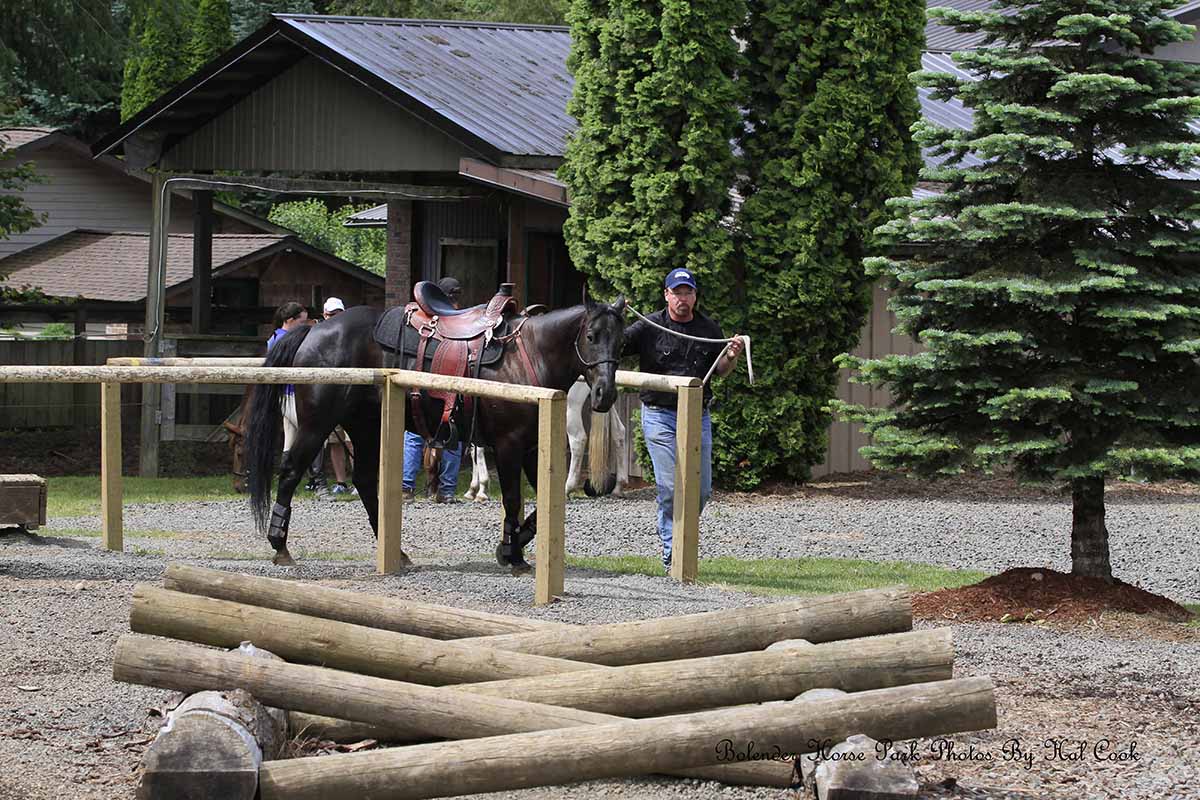Gain Success Navigating a Frustrating Obstacle
by Mark Bolender

The raised back-through can often be a frustrating experience for the horse and rider. I commonly hear this: “I don’t understand why my horse will not trust me more and just do it.” Often their horse is pushy when being handled on the ground and will not navigate the difficult obstacles in a show or on a trail while in hand or being ridden. When I see this behavior I know that the rider must establish a role as leader before the horse will trust enough to give the back- through a try.
Horses operate on instinct. Trust is naturally woven into instinct with a fragile thread, and that trust must be earned. However, trust from a horse is not earned in the same way humans earn it. Instinct will determine if you are “worthy” of a leadership role. Instinct is not right or wrong, it just is. If it determines that you are worthy the horse will at least attempt to navigate or inspect the obstacle. Instinct is a different type of intelligence and, in some ways, a greater type. Never underestimate it.
So, how does all this fit into navigating the raised back-through? It’s simple: establish your role as the alpha mare or leader. This is a comfort for horses instinctively know that the alpha mare will die protecting them. It means that when you ask it to move (whether on the ground or riding) it does so willingly. Since a horse is claustrophobic, it takes trust to commit to backing. The basic skill of moving the horse’s haunches and shoulders is necessary. If these skills are not in your tool bag back up and teach/learn them otherwise it will be a very frustrating experience.
If we are consistent in the cues and remember that the less we do (like move) the more authority we have in the horse’s eyes. In a training situation, your movements mean a lot. If you ask the horse to move and it does not, then you must take action and follow through. If you are not willing to follow through you force your horse to gamble – to decide to follow or not. That’s stressful. An even worse outcome of not following through is that you will lose all credibility with your horse. Indecisiveness means you’re not a leader in the horse’s eyes and they will not want to try. The claustrophobic instinct can only be overridden by the instinct to please the leader; indecisiveness shows a lack of leadership.
You must establish your role as a leader. This does not mean the horse will successfully navigate the obstacle on the first try. But, as long as they volunteer the attempt, you’re making progress. It may be difficult at first but you must remain calm. Show no emotions (like anger) and be very patient. Continue to give clear and consistent signals. Sweet talk and praise are not clear signals. Clear signals let the horse know that it’s wise to trust you. When the horse shows trust and moves willingly, here are the final steps to master the back-through.
1) Walk the horse through from the ground first.
2) Walk the horse part way through and then back out.
3) Allow the horse time to think.
4) Mount up and ride. Check and make sure that you have complete control of the haunches and shoulders of the horse.
5) Repeat steps 1-3
6) DO NOT start looking around while backing, look only once or twice. This will be a big distraction to the horse and will move your body so it can’t concentrate.
7) Walk up facing the entry, pivot on the forehand 180 then line up straight and ask the horse to back.
If any steps are skipped the horse will whip it haunches around and refuse to back through. Understanding and following these steps will enable you to teach your horse effectively; it will lead to trust and a great performance.
Happy Trails and Bolender Blessings
Materials to Build the Obstacle: Six 8’4×6 post and four 10’ poles. Notch the poles so they sit on top of the 4×6 and will fall off when they are bumped.
Published in December 2014 Issue

Mark Bolender is the nation’s leading expert in Mountain Trail, Extreme Mountain Trail, and Competitive Trail. He’s a three-time National Champion and one of the most popular trainers in the country. Today, Mark’s unique style of horsemanship has made the Bolender brand synonymous with these disciplines.
Mark has written for numerous national magazines and authored the popular book, Bolender’s Guide to Mastering Mountain and Extreme Trail Riding. Mark and his horse Checkers hold the sport’s all-time highest honors. Checkers was distinguished by becoming the 2020 Breyer Horse.
Mark and Lee Bolender founded the International Mountain Trail Challenge Association (IMTCA) to promote these sports. Today, the IMTCA trains judges, coordinates activities, and maintains certifications around the world.
Mark owns and operates Bolender Horse Park in Washington State. Mark has also designed and built Mountain Trail courses around the world.

